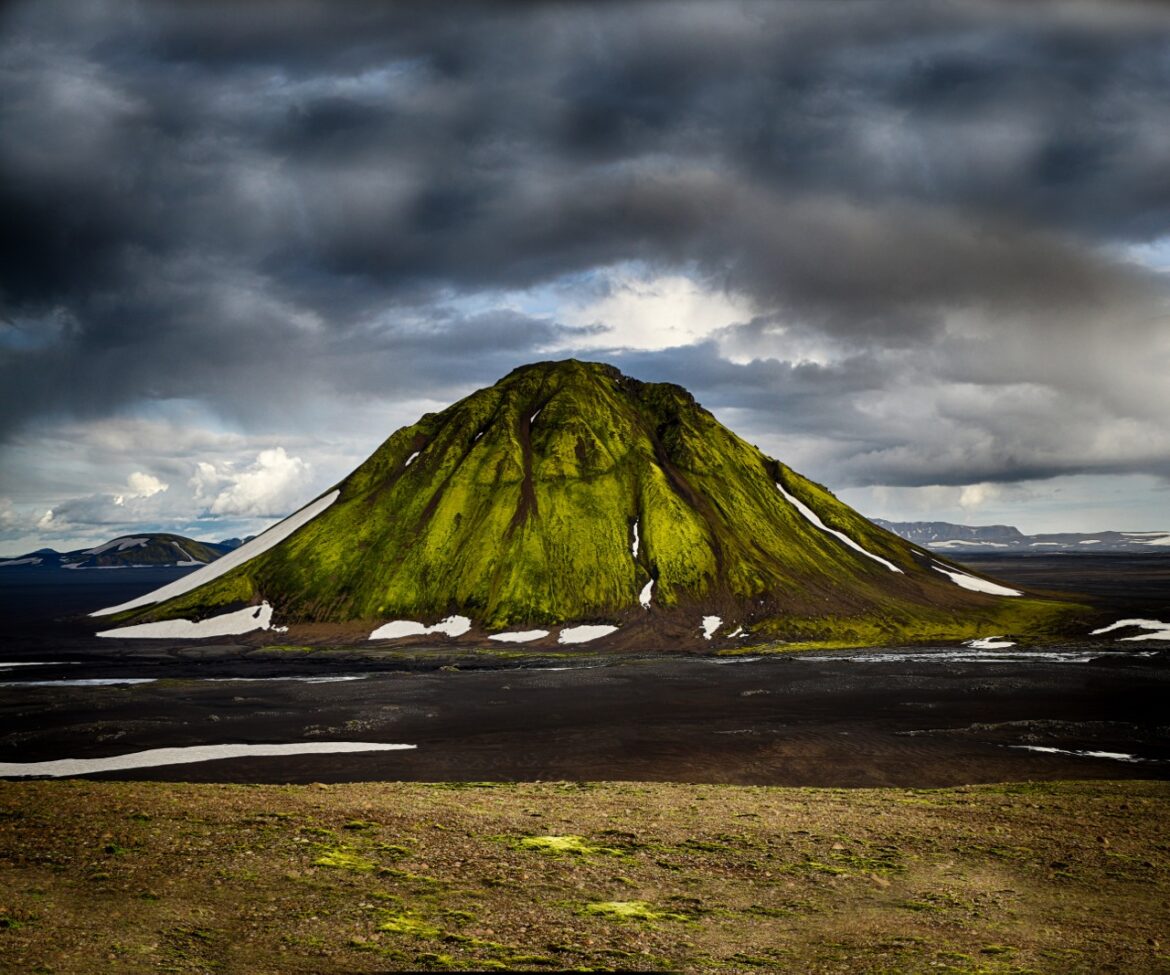A passage between glaciers and volcanoes
Beautiful assisted 6-day walking adventure hut to hut. After climbing and crossing the vast and strange Hrafntinnusker Caldeira, our trail continues through lush green spines and laughing valleys to the entrance of the long narrow black desert of Mælifellssandur which stretches between the caldera and the enormous mass of the Mýrdalsjökull ice cap and leads to Lake Holmsárlón and the Eldgjá fault in the south-east of the Caldera
Except for a lightweight day pack, all equipment and luggage are transported by a 4x4 support vehicle.
To privatize this trek:
This trek, as described here, can be privatized for your family, for your hiking club, for your university, for your company or for your clients if you are a mountain guide:
- either on one of our scheduled dates still available
- or on any other date if availability allows
| Code | From |
to |
Duration |
Price / Estimated |
Language | Avail. |
Book |
|---|---|---|---|---|---|---|---|
To change the indicative price in your prefered currency, choose it from the available list in the upper right-hand corner of this page.Conversion rates are from the Icelandic National Bank |
|||||||
| 2025.TMS.716 | 16 Jul 2025 |
21 Jul 2025 |
6 days |
370000 ISK / 2553 EUR |
International | 10 | |
| 2025.TMS.813 | 13 Aug 2025 |
18 Aug 2025 |
6 days |
370000 ISK / 2553 EUR |
International | 6 | |
Day 1: Reykjavik - Hrafntinnusker Caldeira
Hikes 6-7 hours – ca. 17 km (11 miles) – Alt. 590 m up to 1100
Early morning rendezvous at 7:30 AM with your guide at Reykjavik Central Bus station. Hiking clothes, duffle bag and daypack ready for trekking. The trip begins. Approx. 3 hours (160 km) road transfer to the trailhead. The majestic Hekla volcano rises above a grassy plain and marks the entrance to the high volcanic lands. Probably It is Iceland’s most famous (or infamous!) and active volcano. Hike starts. We climb and start to cross the incredible Hrafntinnusker caldeira from where reach the remote refuge of Dalakofi.
Day 1: Reykjavik -Caldera of Hrafntinnusker
Walk 6-7 hours - ca. 17 km (11 miles) - Alt. 590 m to 1100.
Your guide will meet you in Hella when you get off the bus from Reykjavik (See our practical information for getting from Reykjavik to Hella) and take you to our nearby warehouse. There we will prepare the midday picnic, check your equipment, then load the travel bags, food and equipment into the trailer of our support jeep. 50 km later the track passes the Tindfjöll Massif. Departure on foot in the late morning. The path takes a long and thick palagonite ridge to the northeast which leads to the imposing monolith of Laufafell, an outpost of the Hrafntinnusker caldera. This regular ridge is a balcony over the region: To the right, to the north, a vast territory linked to the Hekla volcanic system with dominant black and red, to the left towards the south, a gray landscape stained with green
Day 2: Caldera of Hrafntinnusker
Walk 6-8 hours – Alt. 590 m > 1100 m > 590 m
A large loop through the shimmering colors of the rhyolitic massifs on the heights of Landmannalaugar. An incredible palette of pastel colors, from blue to pink, including all the possible ochres. Countless fumaroles, pools of sulphureous mud, flows of vitrified obsidian, swamps, clear lakes and immaculate ice caps follow one another as far as the eye can see. We walk along a vast flow of Hrafntinnusker obsidian, “the reefs of raven black”.
Obsidian is a black vitrified lava with sometimes blue or green reflections, which when broken is sharp as a razor blade that spreads here on the soft pastel undulations of acid rocks of the crown of the caldera of the same name. We will carefully see the countless solfataras with pools of bubbling mud, powerful and noisy jets of steam.
Day 3: Hike Ljósártungur to Hvanngil
Hike 7-5 hours – ca. 21 km (13 miles) – Alt. 785 to 550 m (2575 to 1800 feet)
One can admire here the alignment of mountain ranges, all perfectly parallel and aligned in the same direction: the direction of the mid-Atlantic ridge that crosses Iceland from North to South enjoying a spectacular view of three major icecaps : Mýrdalsjökull, Eyjafjallajökull and Tindfjallajökull.
Following the course of the Markarfljót canyon, we descend south through hills of rolling grassland, crossing clear streams.
This very beautiful day also represents the longest stage of this trek, so our assistance jeep will be able to join us that day if necessary and allow some who would like to save themselves not to do everything on foot.
Day 4: Mælifellssandur desert
Hike 5 hours – ca. 15 km (9 miles) – Alt. 550 to 563 m (1800 to 1850 feet)
We cross the sand of Mælifellssandur. In the middle of this strange black flatness stands the solitary cone of Mælifell, covered in fluorescent, green-colored moss. We can explore the extraordinary landscapes between the southern flank of the Torfajökull caldera and the mighty dome of the Mýrdalsjökull icecap. Beneath this huge sheet of ice lies Katla, another of Iceland’s angriest volcanoes. She last erupted in 1918 and is long overdue for another eruption.
Day 5: Strútur - Hólmsárlón – Eldgjá
6–8-hour hike - approx. 19 km - Altitude 563 m
After an unforgettable bath at the end of the world in a hot spring, progress on the banks of the long and narrow turquoise lake Hólmsárlón. At the other end of the lake its spillway falls abruptly in a series of beautiful waterfalls to the superb red crater of Rauðibotnar (Red Bottoms). This crater is an integral part of the great Eldgjá fault. It is the explosive result of the meeting of a river with the fire of an eruptive fault. Once again, this beautiful landscape of red rocks, thick bronze-green moss and fresh torrents would almost make one forget the cataclysmic creation of Iceland and our planet in general.
The fault of Eldgjá, the longest eruptive fissure on earth, today covered by moss and crossed by a clear stream. As large as the Laki eruption was, it was exceeded by Iceland's A.D. 934-940 Eldgjá eruption, which occurred in the same mountainous region. During the six years that this eruption was active, lava erupted from several vents along a discontinuous 75-km-long (47-mile-long) fissure system and buried more than 781 square km (302 square miles) of southern Iceland. Fortunately, huge eruptions like those at Eldgjá and Laki are very unusual; otherwise, life as we know it would probably not be. Though the hazards posed by lava flows and volcanic gas here on the “Big” Island are understandably important to us, they are still tiny in comparison to what our big blue planet is capable of.
At the end of the hike, we reach by jeep the edge of the inhabited lands of the Skaftafellssýsla district, on the edge of the enormous, petrified lava field of Laki where the Skaftá rushes and meanders, a powerful muddy glacial river coming from Vatnajökull.
Day 6: South Coast - Reykjavik
Route 280 km
We return by vehicle to the coastal plain. Return to Reykjavik with our jeep or with a regular bus from Vík-í-Mýrdal at 4pm. Arrival in the late afternoon 6:45pm (The schedule of this day will be specified later)



